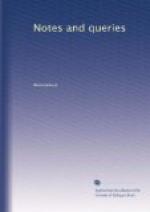“In Gilbert’s History of Cornwall, I saw a brief but striking account, written by a Doctor Ruddell, a clergyman of Launceston, respecting a ghost which (in the year 1665) he has seen and laid to rest, that in the first instance had haunted a poor lad, the son of a Mr. Bligh, in his way to school, in a place called the ’Higher Broom Field.’ This grave relation showed, I thought, the credulity of the times in which the author of it lived; and so I determined to have doctor, boy, and ghost in my story. But whereas, in the worthy divine’s account of the transaction, the ghost appears to come on earth for no purpose whatever (unless it be to frighten the poor boy), I resolved to give the spirit something to do in such post-mortem visitations, and that the object of them should be of import to the tale. Accordingly I made boy, doctor, and the woman (who is said after her death to have appeared to the lad) into characters, invented a story for them, and gave them adventures.”
Mrs. Bray adds—
“Soon after the publication of Trelawny, my much esteemed friend, the Rev. F.V.T. Arundell[1], informed me, that, whilst engaged in his antiquarian researches in Cornwall, he found among some old and original papers the manuscript account, in Dr. Ruddell’s own hand-writing, of his encounter with the ghost in question. This he lent Gilbert, who inserted it in his History of Cornwall; and there I first saw it, as stated above. A few months ago, I purchased some of the reprinted volumes of the Works of Daniel De Foe. Among these was the Life of Mr. Duncan Campbell, a fortune-teller. To my great surprise, I found inserted in the Appendix (after verses to Mr. Duncan Campbell), without either name of the author, reference, or introduction, under the heading, ’A remarkable Passage of an Apparition, 1665,’ no other than Dr. Ruddell’s account of meeting the ghost which had haunted the boy, so much the same as that I had read in Gilbert, that it scarcely seemed to differ from it in a word. The name of Mr. Bligh, the father of the boy, was, however, omitted; and Dr. Ruddell could only be known as the author of the account by the lad’s father calling the narrator Mr. Ruddell, in their discourse about the youth. The account is so strangely inserted in the Appendix to the volume, without comment or reference, that, had I not previously known the circumstances above names by Mr. Arundell, I should have fancied it a fiction of De Foe himself, like the story {242} of the ghost of Mrs. Veal, prefixed to Drelincourt on Death.
“Aware that Mr. Arundell had no idea that Ruddell’s ghost story was to be found in any work previous to Gilbert’s, I lost no time in communicating to that gentleman what I could not but deem a very curious discovery. He assured me there could be no mistake as to the genuineness of the ghost document he had found, as he had compared the manuscript with Ruddell’s




